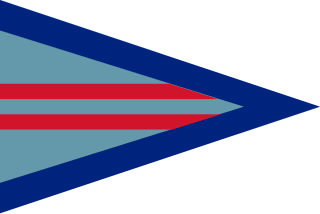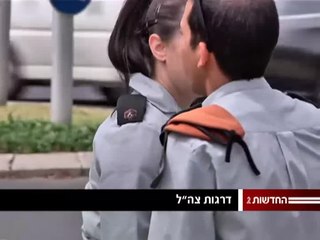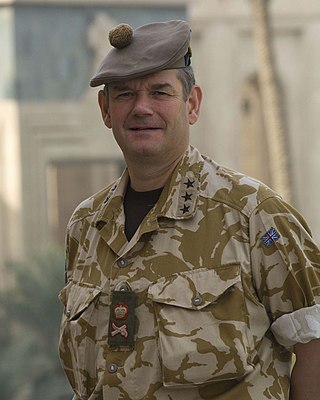
A chevron is a V-shaped mark or symbol, often inverted. The word is usually used in reference to a kind of fret in architecture, or to a badge or insignia used in military or police uniforms to indicate rank or length of service, or in heraldry and the designs of flags.

Military ranks are a system of hierarchical relationships, within armed forces, police, intelligence agencies or other institutions organized along military lines. The military rank system defines dominance, authority, and responsibility in a military hierarchy. It incorporates the principles of exercising power and authority into the military chain of command—the succession of commanders superior to subordinates through which command is exercised. The military chain of command constructs an important component for organized collective action.
Second lieutenant is a junior commissioned officer military rank in many armed forces.
Sergeant is a rank in use by the armed forces of many countries. It is also a police rank in some police services. The alternative spelling, serjeant, is used in The Rifles and other units that draw their heritage from the British light infantry. Its origin is the Latin serviens, 'one who serves', through the French term sergeant.
Commander is a common naval officer rank as well as a job title or "billet" in many armies. Commander is also used as a rank or title in other formal organizations, including several police forces. In several countries this naval rank is termed frigate captain.

Wing commander is a senior commissioned rank in the British Royal Air Force and air forces of many countries which have historical British influence, including many Commonwealth countries but not including Canada and South Africa. It is sometimes used as the English translation of an equivalent rank in countries which have a non-English air force-specific rank structure. It ranks immediately above squadron leader and immediately below group captain.

Air commodore is a one-star rank and is an air officer rank which originated in and continues to be used by the Royal Air Force. The rank is also used by the air forces of many countries which have historical British influence such as Zimbabwe, and it is sometimes used as the English translation of an equivalent rank in countries which have a non-English air force-specific rank structure. The name of the rank is always the full phrase; it is never shortened to "commodore", which is a rank in various naval forces.
This is a list of words, terms, concepts, and slogans that have been or are used by the German military. Ranks and translations of nicknames for vehicles are included. Also included are some general terms from the German language found frequently in military jargon. Some terms are from the general German cultural background, others are given to show a change that was made before or after the Nazi era. Some factories that were the primary producers of military equipment, especially tanks, are also given.

Modern Russian military ranks trace their roots to the Table of Ranks established by Peter the Great. Most of the rank names were borrowed from existing German/Prussian, French, English, Dutch, and Polish ranks upon the formation of the Russian regular army in the late 17th century.
Commandant is a title often given to the officer in charge of a military training establishment or academy. This usage is common in English-speaking nations. In some countries it may be a military or police rank. It is also often used to refer to the commander of a military prison or prison camp.
Colonel is a Canadian Forces rank used by commissioned officers in the Canadian Army and Royal Canadian Air Force. Captain(N) is the equivalent rank in the Royal Canadian Navy. A colonel is senior to the army and air force rank of lieutenant-colonel or the naval rank of commander, and junior to the army and air force rank of brigadier-general or the naval rank of commodore.
In the United States Army, Marine Corps, Air Force and Space Force, major is a field officer above the rank of captain and below the rank of lieutenant colonel. It is equivalent to the naval rank of lieutenant commander in the other uniformed services. Although lieutenant commanders are considered junior officers by their services, the rank of major is that of a senior officer in the United States Army, the United States Marine Corps, and the United States Air Force.

The Israel Defense Forces (IDF) has a unique rank structure. Because the IDF is an integrated force, ranks are the same in all services The ranks are derived from those in the paramilitary Haganah, which operated during the Mandate period in order to protect the Yishuv. This is reflected in the slightly compacted rank structure: for instance, the Chief of Staff is seemingly only equivalent to a lieutenant general in other militaries.

Lieutenant general, formerly more commonly lieutenant-general, is a senior rank in the British Army and the Royal Marines. It is the equivalent of a multinational three-star rank; some British lieutenant generals sometimes wear three-star insignia, in addition to their standard insignia, when on multinational operations.
In the United States uniformed services, captain is a commissioned-officer rank. In keeping with the traditions of the militaries of most nations, the rank varies between the services, being a senior rank in the naval services and a junior rank in the ground and air forces. Many fire departments and police departments in the United States also use the rank of captain as an officer in a specific unit.

A five-star rank is the highest military rank in many countries. The rank is that of the most senior operational military commanders, and within NATO's standard rank scale it is designated by the code OF-10. Not all armed forces have such a rank, and in those that do the actual insignia of the five-star ranks may not contain five stars. For example: the insignia for the French OF-10 rank maréchal de France contains seven stars; the insignia for the Portuguese marechal contains four gold stars. The stars used on the rank insignias of various Commonwealth of Nations are sometimes referred to colloquially as pips, but are stars of the orders of the Garter, Thistle or Bath or Eversleigh stars depending on the wearer's original regiment or corps, and are used in combination with other heraldic items, such as batons, crowns, swords or maple leaves.

Gorget patches are an insignia in the form of paired patches of cloth or metal on the collar of a uniform (gorget), used in the military and civil service in some countries. Collar tabs sign the military rank, the rank of civil service, the military unit, the office (department) or the branch of the armed forces and the arm of service.
A general officer is an officer of high military rank; in the uniformed services of the United States, general officers are commissioned officers above the field officer ranks, the highest of which is colonel in the Army, Marine Corps, and Air Force and captain, in the Navy, Coast Guard, Public Health Service Commissioned Corps (PHSCC), and National Oceanic and Atmospheric Administration Commissioned Corps (NOAACC).

The ranks and rank insignia of the Red Army and Red Navy between 1940 and 1943 were characterised by continuing reforms to the Soviet armed forces in the period immediately before Operation Barbarossa and the war of national survival following it. The Soviet suspicion of rank and rank badges as a bourgeois institution remained, but the increasing experience of Soviet forces, and the massive increase in manpower all played their part, including the creation of a number of new general officer ranks and the reintroduction of permanent enlisted ranks and ratings.









